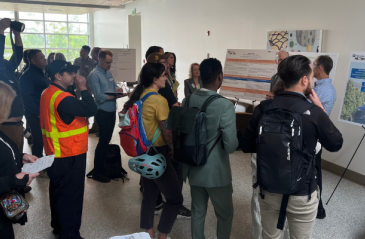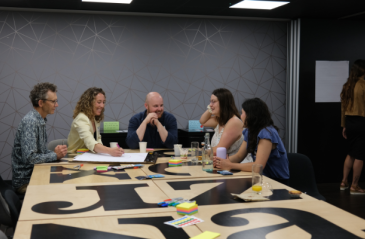
The information barriers holding back climate action and how to break them

Transformation has to be business-driven and understand the stakeholders’ perspective
Share articleRecruit a team who will run the programme after the transformation is complete
Share articleGovernment professionals should under-promise and over-deliver
Share articleWe put our vision for government into practice through learning partner projects that align with our values and help reimagine government so that it works for everyone.
It's fair to say that Greg Farr knows a thing or two about government ICT reform. The ups and downs. The challenges. The frustrations. And, above all, the secrets of success.
His 30 years of government service saw him progress from the mail room of his local tax office through to serving as second commissioner of taxation for the Australian Taxation Office (ATO) and then a five-year stint as chief information officer of the Australian Department of Defence (DoD). Reform, modernisation and impact - particularly through the power of digital technology - were at the forefront of both these senior roles. Although he's been a tech wizard, he understands that transformation has to be business-driven.
“You need to make sure you actually understand what it is you're going to do, from the stakeholders' perspective,” he says, “or make sure you can define what success looks like from their viewpoint, so that they can actually sign up for it. And you have to find some really trusted colleagues that you can actually depend on to run the programme and who will still be there when you go, because otherwise what you've started is likely to just fade away.”
During his tenure as second commissioner of the ATO, Farr oversaw a range of major initiatives. Not only the introduction of a Goods and Services Tax (GST) but also the implementation of a fundamental overhaul of the tax administration systems, dubbed the ‘Change Programme'. These reforms involved the migration from ATO's decades-old technology platform to a more modern architecture that was to deliver improved flexibility in the way the agency conducted its business.
The Change Programme drew on the lessons learned during the introduction of the GST, which was not without some bumps in the road. Key among these was the need to overcome initial opposition from the general public. “There was a quite significant community backlash,” he recalls. “And one of the things a tax administration can't be is at war with citizens. It's a citizens' tax system and it needs their support to operate successfully. So, for the Change Programme the commissioner asked a research company to go out to the community to find out what we needed to do to win confidence for a new tax administration system. From these focus groups we learned that they wanted the tax system to be easier to deal with. They wanted it to be cheaper, particularly from a small business perspective. And they wanted us to deal with them as individuals, not as a number. Everything we then did was framed against these three findings.”
This had significant implications for system design. “We initially looked at it from an IT perspective,” he recalls. “We used to have all our data and we would choose to actually give it to people, but the fundamental change is that it's actually their data. If it's their data, why can't they have access to it? Why can't they update their data easily?”
Farr believes that this shift in mindset led to a number of benefits. “The majority of people comply with the tax system - if they know how and it's easy,” he points out. “Some of the things we did at the time made it easy for them, and made it quicker for them, but at the same time we also sought to design a system where we can catch anomalies in real time. Things like being able to say to them once they're entering data: ‘did you really mean that?' Or ‘last year you said this, why is it different this year?' More smarts built into the front end means less work in the back end.”
This played out through initiatives such as publishing types and volumes of processed returns in regular reports on its website during peak processing periods. Transparency and accountability were also strengthened by a number of external, independent reviews from bodies such as the Australian National Audit Office. And, in addition, new corporate reports were introduced to enhance the visibility of tax return processing and increase capability for early identification of systems issues.
By contrast, the change programme at the DoD had a different dimension, one that was more internal and involved less interaction with the community. In addition to stabilising the department's systems, he also initiated and set in course the defence ICT Strategic Reform Programme, one of the largest IT transformations in Australia, costing hundreds of millions of dollars in IT spending. The imperative for change, it transpires, was clear. “Military commanders and their civilian colleagues were increasingly saying they simply could not do their job any more with the technology,” explains Farr. “It was very fragmented, very old, and unable to present them with the information they needed to make business decisions or to make military decisions.”
Under Farr's leadership, the ensuing reforms - which began in 2009 - sought to radically reform ICT delivery to Australia's military and civilians, and simultaneously achieve $1.9 billion in savings by 2019 to reinvest in the defence portfolio. Simplifying and modernising the core technology ‘backbone', including the network, data centres and desktops and core business systems for HR and estate management, is leading to big improvements at the DoD, not only in IT systems but also in internal business processes.
Farr's work at the ATO and DoD involved substantial changes to the core systems of both organisations. Making an impact in this area is far from easy, and Farr deployed a two-step approach, starting with phasing in the changes in order to help build up goodwill. “It's important to have quick wins and build up that bank of goodwill because you're going to need it, you're going to step up along the way,” he explains.
Farr goes on to say that he and his team then had to lean on external advice to set up for success. “We needed some research capabilities, then we needed some assistance to take that research and put it into what would be the frame of a programme. For a lot of these major transformations of this type, senior executives see them once in their career, which means you don't build up expertise in putting them together. I've seen a couple, but I'm probably the exception rather than the rule. You don't understand the mistakes that are likely to occur, so you need to engage and draw on people who actually do that for a living.”
Core system modernisations also involve a myriad of stakeholders - both internal and external - and Farr says that communication with these groups needs be clear and transparent. At the ATO, this involved recruiting internal ‘change champions'. “I looked for people who were not the ‘best mate', but were people who were outspoken, who had street cred, but also had credibility with senior managers,” he explains. “These were people who were prepared to take the time to actually enter into this process instead of whingeing about it.” This group was involved in critical thinking and planning that went over and above what technology could achieve. “They came up with propositions that weren't just the existing system with some whistles and bells,” says Farr. “Instead, it was fundamental things like opening up everything, linking community systems with tax systems, which at the time was very radical.”
Farr also admits to some regrets - particularly over the amount of time and effort spent in preparing the business case for the proposed changes. More effort should have been made to ensure that the necessary in-house capabilities were available. “The thing that when I look back and I kick myself is that we spent so much time getting the business case right,” he concedes. “The business case was good - even if I do say so myself - but we just didn't have the capability to immediately execute, as we didn't have the right people.”
Farr stepped down from government service in 2012 after his five-year contract at the DoD came to an end. Since then he has spent time working for the International Monetary Fund, looking at programme and project management capability in developing countries. For developing or developed countries, though, his advice to government professionals remains the same: understand the challenge from the perspective of stakeholders; under-promise and over-deliver; and deliver early to build goodwill. His track record in government suggests that they would do well to listen.











